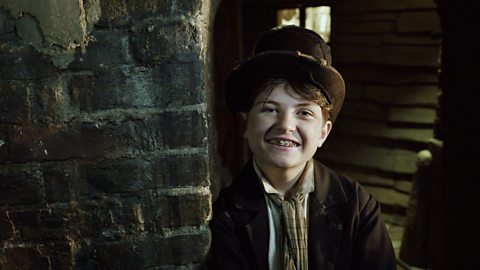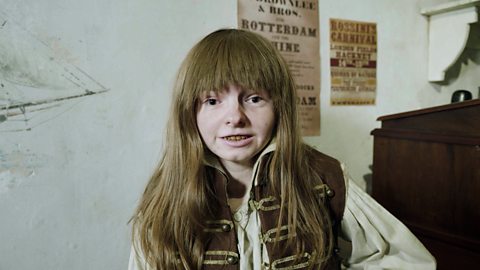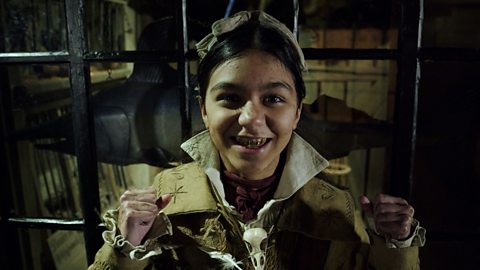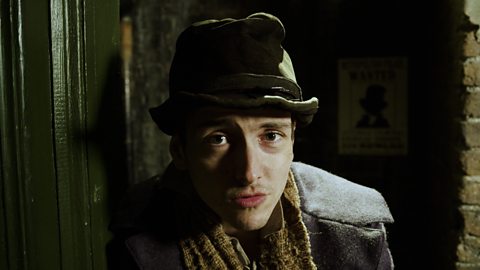DODGER:
Do you want to know what life is like for kids in the 1830s? We'll tell you.
POLLY:
London's full of kids, itÔÇÖs more kids than rats, and they ainÔÇÖt treated any better either.
TANG:
Most of us haven't got any shoes.
MORGAN:
Or warm clothes.
TANG:
Or a house.
MORGAN:
Or parents. I think I'm gonna cry.
TOM:
All we care about is food.
DODGER:
Food.
MORGAN:
All we think about all day, all night, is food.
DODGER:
Food.
TANG:
How to get food.
DODGER:
Food.
TOM:
How to nick food.
DODGER:
Food.
CHARLEY:
But food is dangerous.
DODGER:
Huh?
CHARLEY:
The food in Victorian times can literally kill you.
TANG:
Don't even ask what's in the sausages.
POLLY:
We call them bags of mystery because you never know what you're going to get.
DODGER:
Kids are put to work. They're small so they can go in all the places hefty old adults canÔÇÖt.
TANG:
Like up chimneys.
POLLY:
And down mines.
MORGAN:
Or sweeping in the streets.
DODGER:
I grew up in an orphanage. When I was nine, I was sent to work in a cotton mill. They call me a pauper apprentice. I nearly lost all my digits picking cotton wastage out of mill machines.
CHARLEY:
You get beaten or fined for falling asleep.
TANG:
Or making a mistake.
MORGAN:
Or being late.
CHARLEY:
And the girls in the factories get paid less than the boys.
TOM:
But it's even worse down in the coal mines.
POLLY:
We need a lot of coal in Victorian England to power the trains.
TANG:
And the steam ships.
MORGAN:
And the machines in the factories.
TOM:
Children are useful down the coal mines because theyÔÇÖre smaller, so they can wriggle into tight spaces.
TANG:
And you can pay them less.
CHARLEY:
ItÔÇÖs dark down the mines and a lot of kids get eye problems from straining to see in the dark.
DODGER:
There's a lot of coal dust, so you get breathing problems for being down there twelve to eighteen hours a day.
TOM:
Then there's the constant noise.
TANG:
And rat infestations.
CHARLEY:
The cave-ins.
TOM:
And the explosions!
MORGAN:
What are the other options?
DODGER:
Be a chimney sweep?
TANG:
The tinier you are, the better.
POLLY:
Your arms, elbows, legs and knees get rubbed and scraped raw.
MORGAN:
All the skin's taken off 'em.
DODGER:
The boss will wash the wounds with saltwater and send the kids straight back up the chimney again.
TOM:
Kids would get stuck.
TANG:
Or fall.
CHARLEY:
And their lungs would get damaged by soot.
DODGER:
Some masters would underfeed them so they were skinny enough to shimmy down that chimney.
POLLY:
If youÔÇÖve got a bad master there ainÔÇÖt nothing you can do, you get walloped and shouted at and called every name under the sun and no one does diddly squat to help ya.
CHARLEY:
Tell me about it. I work on the farm scaring birds all day, no matter the weather.
DODGER:
There was the 1833 Factory Act.
POLLY:
That stopped kids under the age of nine from working.
CHARLEY:
But it only applied to textile factories.
TANG:
Most kids don't go to school at all.
DODGER:
Only the rich kids, a lot of them get taught at home, privately like.
TOM:
People with money, they don't want the government telling them what to do with their kids.
CHARLEY:
And no one wants to pay.
MORGAN:
So while theyÔÇÖre all arguing about it, the rest of us ainÔÇÖt getting any education.
CHARLEY:
And when youÔÇÖre poor, what's the point in going to school anyway?
TANG:
If the poor kids don't go out to work, their mums and dads lose a lot of extra cash.
TOM:
And if you're working down the docks or the factories well, you don't need to read or write do ya?
MORGAN:
You might think that sounds cushty but let me tell you, it ainÔÇÖt. I donÔÇÖt even know how to write my own name. I think I might cry again.
TANG:
And I can't count.
POLLY:
Counting is overrated.
DODGER:
Bag of mystery? Let's have a guess as to what's in 'em.
POLLY:
Saw dust?
MORGAN:
Dog guts?
TANG:
Cows udders?
TOM:
A table?
Video summary
In this short film for primary schools Dodger and the gang provide a brief guide to life for children in Victorian Britain, including some of the ways in which children were employed.
Reference is made to a number of common jobs children did, though of course this will have varied depending on their locality.
For comic relief, the film points out that food standards in Victorian times were not regulated and mentions how sausages were also called ÔÇśbags of mysteryÔÇÖ.
This short film is from the 91╚╚▒Č Teach series Dodger's Guide to Victorian Britain.
Teacher Notes
Before watching the film
It will be helpful for you to have some historical context before watching the video with your class. It is during the Victorian period that there is change from children being employed to being educated. The film will provide useful information on the former, though reference is made to only rich children being educated.
Of course, the situation is more complicated as more poor children did go to school once they could no longer work in textile factories and down the mines. This growth in schooling was led mainly by church organisations and so would vary across the country and it was not until the later 19th century that the state accepted it had a role in educating children.
As for richer children, the type of education received depended on your gender. Boys may well have attended one of the well-established public schools, whilst girls may have been educated at home by a private governess.
Questions to consider whilst watching the film
Depending on the focus of your lesson, you may wish to pause the short film at certain points to check for understanding, asking questions such as:
- Why were children thought to be better workers than adults at that time?
- What evidence was there that some of the jobs children did were dangerous?
- How would the jobs have had a bad effect on the health of children?
- What do you think might be the reaction of employers and parents to laws which prevented children from working?
Alternatively the questions could be asked at the end of the video.
After watching the film - activities to further explore learning
Historical enquiry - History is always more meaningful to children if it can be linked to the local area and to places of which they may be aware. This topic provides excellent opportunities for children to discover the excitement of studying primary historical sources:
- Pupils could investigate child labour by exploring artefacts and documents. Local libraries and museums may well have primary sources related to the jobs in a particular area. Having the opportunity to handle historical artefacts has more learning potential than seeing pictures of them in books or on the internet. If this is not possible, the National Archives website has resources .
- If your school has access to local census data, the children could investigate to see if they can identify any of the jobs done by children; it is possible that the names of some of the jobs are unfamiliar and that in itself will require further research. To make the enquiry manageable, it may be worth just selecting one street in the locality. The census records before 1851 are not always the most reliable and accurate, but will provide more evidence of child labour. Data from 1851 will probably reveal that younger children are scholars whilst older children will have jobs. Data from the later Victorian period should highlight the growth of education.
- Depending on the history of your school, it is possible that there may be primary sources of the school dating back to the Victorian period (for example, log books, registers, punishment books and possibly photographs). The pupils could investigate any relevant documents to see what they can learn from these sources about 19th century schooling.
Concept of change and continuity - History is always more interesting if the children find it challenging to children. By later Key Stage 2, knowledge should not be limited to the parameters of a video such as this and pupils need to place this in a wider context by making connections and drawing contrasts. For this topic, it could be approached on two levels.
- Firstly, the children can compare and contrast the similarities and differences between their lives and those of the similar aged children in the video. There are opportunities for drama and role play, as this could be framed as an imaginary meeting between a child today and one from Victorian times, talking about their daily lives.
- One way to develop progression in learning is to explore change within an historical period, by identifying the changes between the lives of children in the early and the late Victorian periods. The video does not reference the fact that children were increasingly prevented from working by the government. There are a number of key acts of parliament passed throughout the 19th century; two of the most important being the 1833 Factory Act and the 1842 Mines Act. This meant that there were changes in the lives of children at the start of VictoriaÔÇÖs reign in 1837 and when she died in 1901. One way of capturing similarities and differences is through a Venn diagram with two circles, entitled Children in 1837 and Children in 1901, to record the differences, and the overlapping circle to record the similarities between 1837 and 1901.
- Even though laws had been passed, it did not mean that they were followed and there is an investigation on the , encouraging the children to consider; Did it solve the problems of children in factories?
England
From the History national curriculum
Pupils should:
- understand historical concepts such as continuity and changeÔÇŽsimilarity, difference.
- understand the methods of historical enquiry, including how evidence is used rigorously to make historical claims.
- gain historical perspective by placing their growing knowledge into different contexts, understanding the connections between local, regional, national ÔÇŽ history.
Northern Ireland
From the statutory requirements for Key Stage 2: The World Around UsPupils should be enabled to explore:
- Change over time in places.
To provide a balance of experiences in History pupils could study:
- Some of the characteristics of past societies and distinctive features of life in the past.
Teaching should provide opportunities for children as they move through Key Stages 1 and 2 to progress:
- from identifying similarities and differences to investigating similarities and differences, patterns and change.
Scotland
From the Experiences and Outcomes for planning learning, teaching and assessment of Second Level Social Studies
- I can use primary and secondary sources selectively to research events in the past.
- I can compare and contrast a society in the past with my own and contribute to a discussion of the similarities and differences.
Wales
From the new Humanities Area of Learning and Experience
School curriculum design for History should:
- develop historical ÔÇŽ source-based skills.
- develop rich content across the time periods, through which learners can develop an understanding of chronology through exploring ÔÇŽ change and continuityÔÇŽthe use of evidence.
- expose learners of all ages to a range of historical periods on a local, national and global scale.
Principles of progressionDescriptions of learning for Progression Step 2
Enquiry, exploration and investigation inspire curiosity about the world, its past, present and future:
- I have been curious and made suggestions for possible enquiries and have asked and responded to a range of questions during an enquiry.
- I have experienced a range of stimuli, and had opportunities to participate in enquiries, both collaboratively and with growing independence.
Human societies are complex and diverse, and shaped by human actions and beliefs:
- I can recognise similarities and differences between peopleÔÇÖs lives, both in the past and present.
- I can identify aspects of life in my community that have changed over time.
Dodger's guide to poverty and the workhouse. video
In this short film for primary schools Dodger and the gang provide a brief guide to the Victorian workhouse and the common diseases from the time, particularly cholera.

Dodger's guide to key inventions. video
In this short film for primary schools Dodger and the gang provide a guide to those inventions from the Victorian era which changed lives then and now.

Dodger's guide to Victorian London. video
In this short film for primary schools Dodger and the gang provide an introduction to Victorian London which was, at that time, the biggest city in the world.

Dodger's guide to crime and punishment. video
In this short film for primary schools Dodger and the gang provide a brief guide to crime and punishment in Victorian Britain.
